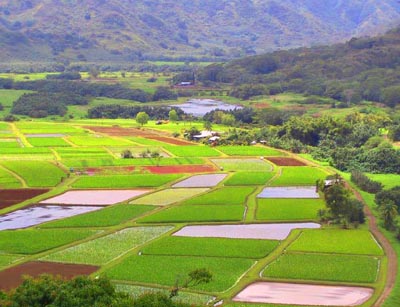
Beautiful and Bountiful - Hanalei Taro Ponds
<
Hanalei Valley, with its vast expanse of mountain-framed green, is one of Hawaii's most photographed landscapes. But the neat, lush fields offer more than just a pretty picture. They also provide two-thirds of the state;s
taro crop and important habitat for endangered native water birds.
Hanalei Valley has long been a center of agriculture. One of Hawaii's
oldest archaeological sites was excavated in Hanalei, indicating humans
might first have cultivated food in the valley as early as 700 AD. The area
is ideal for growing the Polynesian staple, taro, because it receives
abundant rainfall and the river runs year round, providing ample irrigation.
Westerners later brought other crops, with Amfac trying to raise sugar,
oranges, mulberry and cattle. But none of these did well in Hanalei Valley,
where rainfall can total 180 inches annually. By 1850, the Chinese who came
to work in the sugar fields had found a new use for the wetlands and began
farming rice, their staple food.
Rice soon became a huge industry in Hawaii, second only to sugar. Some
90 percent of the crop was raised on Kauai and Oahu; even Waikiki's
extensive wetlands -- later drained for hotels -- were cultivated. By the
1900s, rice was being grown in river valleys stretching from Waimea to
Wainiha, including every flat area in Hanalei.
Many Japanese, who came as the second wave of immigrant workers,
embraced rice farming when their plantation contracts ended. They also
operated some of the neighborhood mills where the grain was hulled and
polished into white rice.
Hawaii's rice industry began to decline in the 1920s when faced with
competition from California, which produced rice more cheaply. Hawaii
farmers also grew all different varieties, which made standardized marketing
impossible. The last stronghold for rice was Hanalei, where it was the
mainstay of the town's economy, but by 1963, the rice industry was pau on
Kauai.
Little remains of that era, save for the Haraguchi Rice Mill in Hanalei
Valley. It is the only mill left in the entire state, and is on the National
Register of Historic Places. The railroad tracks at Hanalei Pier are another
remnant of this era. Milled rice was barged down the Hanalei River to the
Weke Road landing, taken by hand cart to the pier and sent by rail car to
the waiting ships. Rice from Kauai was shipped throughout Hawaii and even to
the mainland, making Hanalei one of Kauai's three main seaports during the
heyday of rice.
After the collapse of rice, many Hanalei farmers began growing
vegetables and then slowly converted their fields to taro. Some of these
farms now supply Hanalei Poi Co., but most of it is shipped to the poi mills
in Honolulu. The most commonly grown commercial cultivar for poi is maoli
lehua, which once was produced exclusively for consumption by the ali`i, or
chiefs. Taro farmers typically do not use pesticides on their crop, although
they may use herbicides to control weeds on the loi (field) banks.
In 1972, the U.S. Fish and Wildlife Service purchased 917 acres on both
sides of the Hanalei River mauka of the bridge to create a refuge for four
endangered water birds, the `alae ke`oke`o (coot), ae`o (stilt), `alae `ula
(gallinule) and the koloa maoli (duck). Nine farmers now grow taro on refuge
land leased from the federal government, while other Hanalei farmers
cultivate privately owned land stretching toward town.
Taro farmers now are facing a major threat, the apple snail. It was
intentionally brought in from Asia as a food source, and has since invested
waterways and loi around the state. The snails actually eat the lau (leaves)
and chew into the corm, leaving hard, scab-like lesions in the taro skin
that must be cut out at the poi mill, reducing yield and slowing down the
milling process.
Apple snails also pose a health risk, inflicting long, deep cuts on the
hands and feet of taro farmers who traditionally work barefoot in the loi
while planting, weeding and harvesting their crop. These cuts increase their
risk of contracting leptospirosis, a bacterium carried by mammalian feces
and urine and found in all fresh water in Hawaii. Those afflicted with lepto
often experience flu-like symptoms, and it can be fatal.
The apple snail and its ramifications for farmers and the environment
provide one compelling example of Hawaii's rampant alien species problem.
Some farmers fear that if the snails aren't controlled, taro may no longer
be a viable crop, signalling a tragic end to an agricultural land use legacy
that began 1300 years ago.
|



















 Beautiful and Bountiful - Hanalei Taro Ponds
Beautiful and Bountiful - Hanalei Taro Ponds